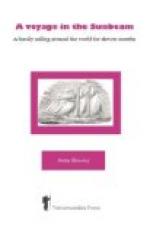After a long day’s shopping, we went to dine, in real Japanese fashion, at a Japanese tea-house. The establishment was kept by a very pleasant woman, who received us at the door, and who herself removed our exceedingly dirty boots before allowing us to step on to her clean mats. This was all very well, as far as it went; but she might as well have supplied us with some substitute for the objectionable articles, for it was a bitterly cold night, and the highly polished wood passages and steep staircase felt very cold to our shoeless feet. The apartment we were shown into was so exact a type of a room in any Japanese house, that I may as well describe it once for all. The woodwork of the roof and the framework of the screens were all made of a handsome dark polished wood, not unlike walnut. The exterior walls under the verandah, as well as the partitions between the other rooms, were simply wooden lattice-work screens, covered with white paper, and sliding in grooves; so that you could walk in or out at any part of the wall you chose, and it was, in like manner, impossible to say whence the next comer would make his appearance. Doors and windows are, by this arrangement, rendered unnecessary, and do not exist. You open a little bit of your wall if you want to look out, and a bigger bit if you want to step out. The floor was covered with several thicknesses of very fine mats, each about six feet long by three broad, deliciously soft to walk upon. All mats in Japan are of the same size, and everything connected with house-building is measured by this standard. Once you have prepared your foundations and woodwork of the dimensions of so many mats, it is the easiest thing in the world to go to a shop and buy a house, ready made, which you can then set up and furnish in the scanty Japanese fashion in a couple of days.




